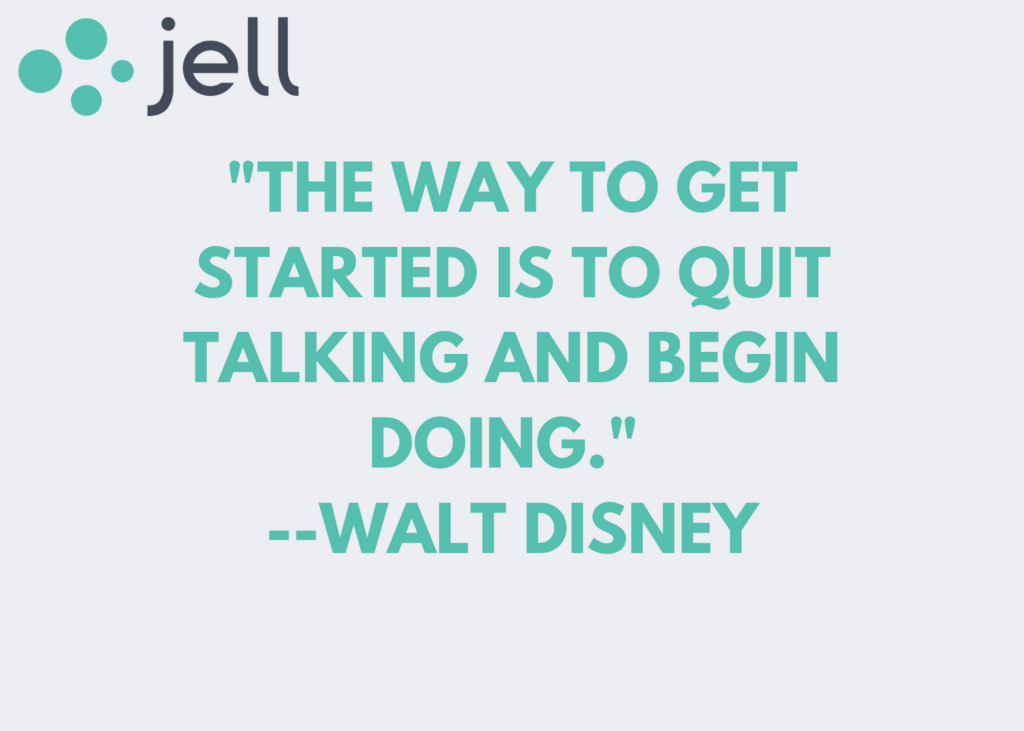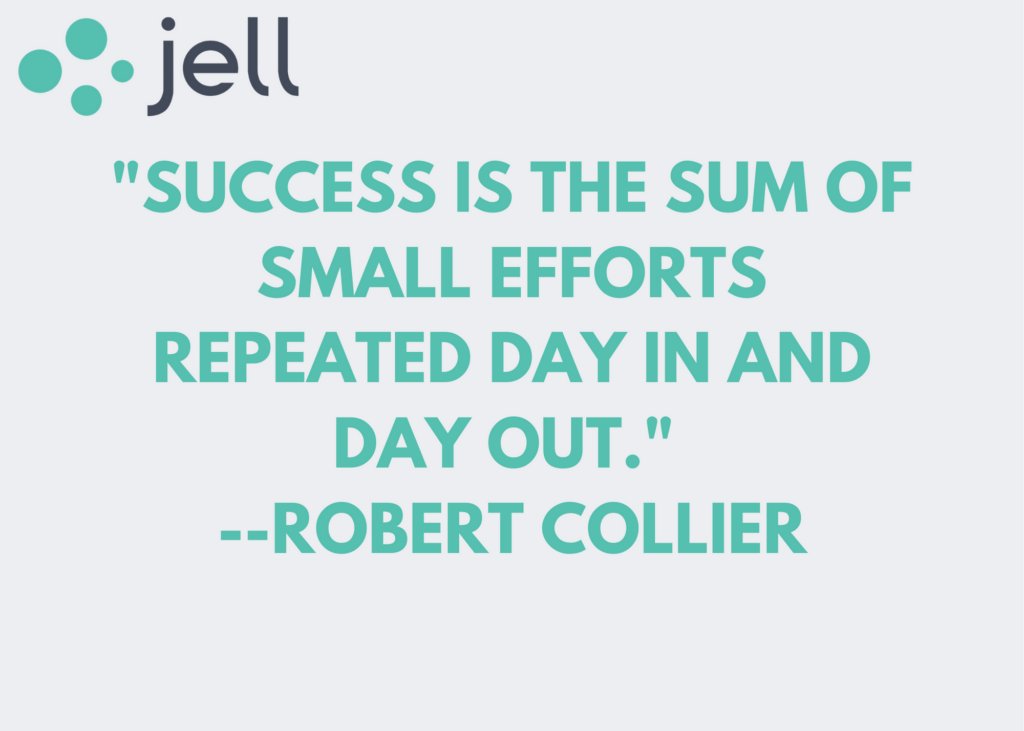
As a manager, it can be very tricky to truly know how your team is doing in all aspects of their work and on a personal level, too. Whether you work remotely or in-person, or a combination of both, establishing regular, routine check in meetings can be a huge help in shedding light on this. Here, we’ve provided some background for you on what a check in meeting is and it’s importance, and how often and in what format you could go about conducting them. We’ve also thrown in a handy employee check in template along with some sample topics and questions you could use to guide these important conversations. Finally, we’ve introduced Jell, a handy tool to make your check in meetings run smoothly for everyone. Good luck!
To make the most out of your one-on-one meetings.
14-day free trial. No credit card required.
Related Articles
Top Tips for Managing Remote Teams Successfully
28 One-on-One Meeting Questions to Improve Communication in the Workplace
61 Useful Check-In Questions for Remote Teams
What is a Check In Meeting?
A check in meeting is a 10-15 minute meeting between you and each of your team members, one-on-one. Managers usually facilitate these meetings on a daily or weekly basis to go through daily progress and engagement of their team members. They can use different tools, like Jell, to guide the meetings and make sure they’re quick and efficient. More formal individual one-on-one meetings or performance reviews typically go through a team member’s performance, goals and engagement annually, quarterly or monthly. A check in meeting, on the other hand, focuses on your team’s day-to-day needs, progress, and attitude or outlook. Check in meetings are not only about managing your team’s performance, but they’re also about building relationships. So, it’s critical to listen to your team and consider their questions and concerns as you collaborate to find solutions. When you treat your people with respect and fairness, they’ll be more engaged and likely to deliver better results.
Why Conduct Check In Meetings?
Check in meetings encourage teamwork and collaboration, and they’re a fantastic way for managers to stay updated and help their team on a day-to-day basis. As a manager, check in meetings can help you:
- Stay up-to-date on current projects, challenges, and successes,
- Reinforce your team’s objectives, and
- Discover potential issues with team engagement in a timely way, as they come up.
When you conduct daily or weekly check in meetings, you have the opportunity to connect with your team, learn of any potential problems early on before they become big obstacles, and adapt to changes as needed. These meetings are also important for maintaining a positive and productive relationship with your team, keeping performance at a good pace, and aligning everyone’s tasks with the goals of both the team and organization overall.
Importance and Benefits of Check In Meetings

Check in meetings can help you do many things, some of which we get into below.
Create and Nurture Relationships
You’ll only be successful when your team trusts you, and building relationships with them will help you achieve this. So, it’s important to connect with your team in a personal way, beyond work. This doesn’t mean crossing uncomfortable lines or anything, but taking opportunities to bond with simple questions like, “What did you do over the weekend?” or, “How are your kids doing?” can go a long way in establishing rapport and trust, and, ultimately, building relationships. When you get people laughing and talking and enjoying their time at work, it encourages them to bring their best each day.
Ease Tension and Stress
It’s normal for your team to feel stressed when it comes to individual meetings with their superiors. Help alleviate some of that by reminding them that check in meetings are for their benefit, and they’re really a chance to ask you for what they need. When your team is stressed, you’ll only get unfavorable results, so it’s in everyone’s best interest to make sure they’re feeling comfortable with their workload.
Keep Your Team Engaged
Check in meetings are important because they help you become a high-performing manager, which includes creating and fostering an engaged and productive team. To create this in an atmosphere that promotes teambuilding requires building connection and trust between you and your team, which can be achieved by:
- Taking an active role with your team members at work,
- Helping your team members set goals and prioritize their tasks, and
- Keeping your team accountable for their performance.
In fact, when managers know what their team members are working on, their team is nearly 7 times more likely to be engaged than disengaged. On the flip side, if they feel ignored by their managers, team members are about 15 times more likely to be disengaged than engaged.
Learn How to Communicate Effectively
Learning to communicate in various types of meetings and situations is important. For instance, if a team member is having a hard time at home to the point it’s affecting their performance at work, they probably won’t be comfortable sharing this in a company-wide meeting. A check in meeting one-on-one with you gives them a safer, more relaxed environment to share. Once you understand what’s behind any negative performance, you’ll be more inclined to empathize, help them out and give them a break if it’s warranted.
Save Time

A great thing about check in meetings is that they are not only short by nature, but they automatically shorten other meetings that could otherwise run longer (like formal performance reviews). The reason for this is you and your team members have already had the chance to catch up on important things which can be condensed or removed from the meeting altogether.
As well, check in meetings offer many other benefits. Some of these include allowing:
- Your team to continuously stay busy, confidently do their jobs, and receive relevant and timely feedback as they work.
- You to stay updated daily, more easily manage projects, help your team with questions and make changes if needed.
- Your organization to adapt to changing circumstances and be more competitive.
Daily Standups, Check-Ins, OKRs.
Check In Meeting Frequency and Format

It’s important to strike the right balance between checking on your team members too much and not enough. Just the right frequency of check in meetings will keep you from being seen as micromanaging or not being hands-on enough. But, how do you know what’s best for your team? First off, you need to understand your team’s needs and culture. At smaller, tighter-knit organizations, a weekly check in should work well. However, in many larger companies, daily check in meetings might be best. Whether or not your team works remotely might also inform your strategy here — if you’re not in the office, more frequent check ins could be needed to make sure everyone’s communicating well and on the same page. A tool like Jell makes it so easy to schedule check in meetings at the frequency and length you and your team need.
Daily Check In Meetings
When you hold daily check-in meetings, each team member has the chance to give you a quick status update on what they’re doing and how it’s going. You can do this in person, on the phone, or online via chat, email, or video, or you could even do it in a team stand-up meeting to save time and ensure the whole team knows and is aligned with what each person is up to. Daily check ins allow you to easily and quickly understand what’s urgent and important that day, and they allow your team to be accountable for their work. The meeting agenda does not need to be complex, as long as it addresses what they’re:
- Currently working on,
- Planning to do tomorrow or this week, and
- Needing help with.
Weekly Check In Meetings
Think of a weekly check in meeting as similar but more involved than its daily counterpart. It can be somewhat of a kickoff for each team member’s priorities that week, plus a quick summary of what they accomplished the previous week and how they could do better this time around. Weekly check ins can also be conducted in person, on the phone, or online, and in an individual or group setting.
Check In Meeting Agenda
You can structure your check in meetings in a simple format to ensure your whole team’s time is spent wisely and productively. It’s always a good idea to create a recurring meeting agenda template as a guide for what you’ll discuss and about how long each item should take. This will help you stay on track and focused. Save this template to repurpose for future meetings, so you won’t have to spend time recreating it from scratch. You might find your meeting topics are different from team member to team member since everyone’s needs vary. So, you could always have separate agenda templates for different people and save even more time when it comes to planning.

Tips for Effective Check In Meetings
Follow these tips to conduct efficient and productive check in meetings your team will see great value in.
- Plan ahead. Make sure team members expect the meeting and have time to plan for it with useful updates and thoughtful insight. That means sending out a calendar invitation and agenda with plenty of notice. And if you schedule regular, recurring meetings, your team will come to expect them with no surprises.
- Be brief and specific. It’s easy to go off on a tangent with lots of feedback or questions, but remember why you’re there and keep the agenda focused and the meeting on time. You can always take notes of items that need a follow-up meeting later on.
- End with solid to-dos or learnings. Everyone should leave check in meetings with a clear understanding of what needs doing and by when along with who’s doing what. That means you need to do your best to avoid confusion. As the meeting ends, be proactive and ensure nobody has questions. This will avoid things from being missed, confirm that your team knows how to do better, as well as make it easier for you to track performance and hold people accountable.
- Get feedback from your team. You might feel like you’re giving your team useful and meaningful feedback at these meetings, but you need to make sure the feeling is mutual. Check in after the meeting with your team to ensure they do in fact understand how they’re performing and what they can improve for next time, and know that you appreciate their work. A quick 2-3 question poll post-meeting can shed a lot of light on this.
- Use a check in meeting tool. A check in meeting tool like Jell allows you to easily schedule recurring check ins as often as works best for your team, and it helps you prepare by asking advance questions, so you’re most productive during that meeting.

Check In Meeting Tools
Another great way to run stellar check in meetings is with a productivity tool like Jell. As a super easy-to-use platform to get the most out of your team’s time, Jell makes your check in meeting prep a breeze. You can set up recurring check ins at the frequency that best suits you and do everything you need to prep. Then, get all the information you need in advance to be productive. Following this tried and true method will help you help your team to grow individually and together while achieving more without obstacles.
The weekly recap check in is a common use case for check ins. You might find it very useful at the end of the week. You could ask your team things like:
- What was your biggest accomplishment this week?
- How many clients did you meet with this week?
- How many new users converted to a premium account?
Daily Standups, Check-Ins, OKRs.
Popular Articles
Increase Team Engagement
Remote Work Productivity – How to Be More Productive At Home
5 Ways Effective Teams Run Daily Slack Standups
Another common use case for check in meeting tools like Jell is to communicate up in your organization. As a manager, you’ll often need to communicate things like your team’s milestones, key accomplishments, and goal progress. Check ins give you the chance to communicate easily and quickly up the organizational ranks. For this purpose, ask your team questions like:
- What major milestones were achieved this month?
- Are there any risks or issues the executives need to know?
- How much of your capacity is currently being utilized?
See for yourself how Jell works for check ins, along with daily standup meetings and OKR goals:
Now that you understand how check in meetings work, you can make the most of them with our employee check in template. You’ll also get the most out of your team by using these tips, tricks, and questions.
To make the most out of your one-on-one meetings.
